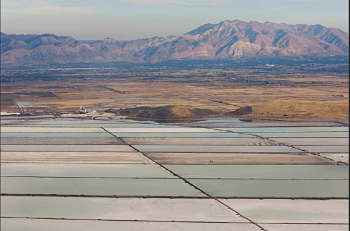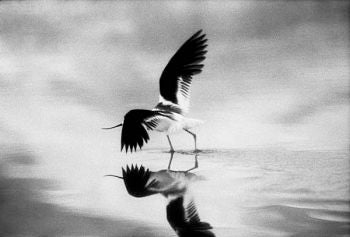
Evaporation ponds in the eastern portion of the Great Salt Lake. Courtesy of Great Salt Lake Minerals.
Say you’re a newbie farmer, and your buddy gives you some organic potash to try out on a field. You can bet it came from the
Great Salt Lake, that big ol’ water body in Utah and the country’s main source for natural, unadulterated sulfate of potash.* The company that produces the fertilizer—the
Great Salt Lakes Minerals Corporation (GSLM)—has had expansion plans for a while, accompanied by environmentalist backlash. Now GSLM has announced a project alternative that it says will require less water for its operations. Yet, some people still aren’t convinced that the 75-mile-long, 35-mile-wide aquatic resource will be spared from worrisome impacts.
Aside from the lake’s inorganic riches—it also produces salt and magnesium chloride—a trove of organic ones thrive on its saline waters. “It is a cauldron of life, by any standard North America’s single most important interior wetland for birds,” writes
Audubon columnist Ted Williams in “
Salt on New Wounds.” “At least 257 species breed or refuel here. Some five million waterfowl, representing 30 percent of the Pacific flyway population, feed and nest in the lake’s 400,000 acres of marsh. And its five major bays have been designated globally Important Bird Areas.” (The birds feed on invertebrates that live in the lake.)

An American avocet in Farmington Bay, part of the Great Salt Lake. Photo by Rosalie Winard.
The GSLM’s updated plan aims to triple the space taken up by its evaporation ponds that collect minerals from 73 square miles to 215, while reducing the water initially requested for production by more than 50 percent. Specifically, the original plan required 353,000 acre-feet of water; the new one calls for 150,000. That increased efficiency will come from a new dike technology, which GSLM also intends to apply to its existing structures which are leaking—a sign of their 40-year-old age.
GSLM’s expansion will also occur incrementally—a more desirable process, according to the company's spokesperson, Dave Hyams, because “you wind up being able to review the impacts in chunks rather than trying to assess the impact of what everything would be at once,” he told me in a recent interview. That way, “the company and public agencies can monitor the lake’s ecology” as well as minimize its near-term water use, stated a November 12th
press release. If methods used during the first phase work well, for example, they can be applied to a second phase.
Not everyone’s mollified.
Friends of Great Salt Lake, an environmental organization that (along with the National Audubon Society) had sued the GSLM over its former plan, opposes the revised version as well. It's concerned that any further expansion “could jeopardize water levels in the lake, threaten public health from air pollution from new expanses of dry lake bed, and threaten nesting colonies for pelicans and other important species,” according to a
press release from the organization. Plus, the new request for 150,000 acre-feet of water “is still a huge amount,” executive director Lynn de Freitas told me in a recent interview.
The incremental expansion isn't satisfying to her group, either. “They say this [phased] approach will allow for impacts on the lake to be monitored before the next phase commences,” de Freitas said in the press release. “Rather than making sure we understand those impacts properly in advance, as the law requires, they now propose to develop first and study the effects later. By then it may be too late to protect the Lake.”
The Great Salt Lake’s water level is known to fluctuate, according to Hyams. Currently, “it’s right where it was back in 1967 when they built the first pond,” he says. To de Freitas, however, there's no certainty lake levels won't decline in the future. The GSLM is “essentially speculating with the resource, and this is a public trust—it belongs to the people of Utah,”
she told KSL Broadcasting. De Freitas is particularly concerned about GSLM’s expansion into a vital portion of the lake called Bear River Bay. “This is a highly productive area,” she told me.
Nothing is yet set in stone yet, however. The U.S. Army Corps of Engineers must complete a draft environmental impact statement on the project alternative to see if any revisions are necessary. To de Freitas, the main question boils down to, “what’s the overall bottom line value here?” In other words, is the salt (and potash) worth its lake?
*this sentence was amended at 4:34 pm on 11/17/10.



